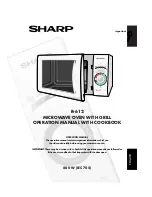
10
TIPS AND ADVICE
TIME SETTINGS
In general the thawing, heating and cooking times are
significantly shorter than when using a conventional
oven. For this reason you should adhere to the
recommended times given in this cookery book. It is
better to set the times too short, rather than too long. Test
the food after it has been cooked. It is better to have to
cook something for a little longer than to overcook it.
INITIAL TEMPERATURES
Thawing, heating and cooking times are dependent
upon the initial temperature of the food. Deep-frozen
food and food stored in a refrigerator, for example,
requires longer than food which has been stored at
room temperature. For heating and cooking, normal
storage temperatures are assumed (refrigerator
temperature approx. 5°C, room temperature approx.
20°C). For thawing the temperature of the deep
freeze is assumed to be -18°C.
COOKING TIMES
All the times given in this cooker y book are
guidelines, which can be varied according to the
initial temperature, weight and condition of the
food (water or fat content etc.).
SALT, SPICES AND HERBS
Food cooked in your microwave retains its individual
flavour better than it does when conventional
preparation methods are used. For this reason you
should use salt sparingly and normally add it only after
cooking. Salt absorbs liquid and dries out the outer
layer of food. Herbs and spices can be used as normal.
ADDITION OF WATER
Vegetables and other foods with a high water content
can be cooked in their own juice or with the addition
of a little water. This ensures that many vitamins and
minerals are preserved.
FOOD IN SKINS OR SHELLS
Foods such as sausages, chickens, chicken legs,
baked potatoes, tomatoes, apples, egg yolks or such
like should be picked or pierced with a fork or small
wooden skewer. This will enable the steam which
forms to dissipate without splitting the skin or shell.
FATTY FOODS
Fatty meat and layers of fat cook better than lean
portions of meat. Before cooking, cover the fatty
portions with a piece of aluminium foil or place the
food with the fat side down.
LARGE AND SMALL QUANTITIES
Microwave times are directly dependent upon the
amount of food which you would like to thaw, heat
or cook. This means that small portions cook more
quickly than larger ones. As a rule of thumb:
TWICE THE AMOUNT = ALMOST TWICE THE TIME
HALF THE AMOUNT = HALF THE TIME
DEEP AND SHALLOW CONTAINERS
Both containers have the same capacity, but the
cooking time is longer for the deeper one. You
should therefore choose as flat a container as
possible with a large surface area. Only use deep
containers for dishes where there is a danger of
overcooking, e.g. for noodles, rice, milk etc..
ROUND AND OVAL CONTAINERS
Food cooks more evenly in round or oval containers
than in containers with corners, since the
microwave energy concentrates in the corners and
the food in these areas could become overcooked.
ARRANGEMENT OF FOOD
Place a number of individual portions, such as small
pudding moulds, cups or potatoes in their jackets, in
a circle on the turntable. Keep the portions at a
distance from each other so that the microwave
energy can reach the food from all sides.
COVERING
Covering the food retains the moisture within it and
shortens the cooking time. Use a lid, microwave foil
or a cover. Foods which are to be crispy, e.g. roasts
or chickens, should not be covered. As a general
rule, whatever would be covered in a conventional
oven should also be covered in a microwave oven.
Whatever would be uncovered in an ordinary oven
can also be left uncovered in a microwave oven.
TURNING
Medium-sized items, such as hamburgers and
steaks, should be turned over once during cooking,
in order to shorten the cooking process. Large items,
such as roasts and chickens, must be turned, since
the upper side receives more microwave energy and
could dry out if not turned.
STIRRING
Stirring the food is necessary, since the microwaves
begin by heating the outer areas. The temperature
is thereby equalised and the food heats up evenly.






































